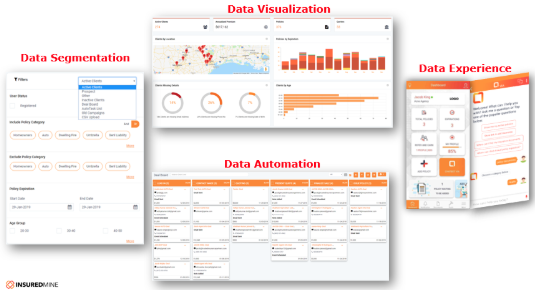To complement recent advice from our guest bloggers, let’s consider the political dimension of applying analytics in business.
Annette and
Peter have shared useful tips on applying analytics for both
customer experience and
marketing. However, unlike in the classroom, advancing such use of analytics in business always involves politics.
Over the years, as well as
protecting technical stars from performance management systems, I have often had to mentor them on politics. Analysts can be idealistic and naive when it comes to the political dimension of office life.
So, in this post, I suggest a simple framework to bear in mind when
interacting with your stakeholders. I hope it helps you navigate the political dimension, or to
coach your team to do so.
A framework for the political dimension of stakeholders
I have shared before on the importance of
mapping your stakeholders and
segmenting them, so you can
adjust your style to suit them. Beyond this, there is a need to be aware of the political dimension and to act accordingly.
Now, the precise details of political implications and game playing in each organization will vary. You will know better than I do what are long-term versus short-term priorities and how different stakeholders might be affected.
What I want to share is a framework for identifying where political considerations matter and for which stakeholders.
The 2×2 grid was developed by Simon Baddeley (
Birmingham University) and Kim Turnball James (
now at Cranfield). It is based on their research within the domain of local government, but their findings accord with my experience of working in large corporations.
Their
analysis of research findings led them to segment people into one of the following four quadrants. These are defined by the twin dimensions of
reading (political awareness – ability to read what is really going on) and
carrying (political actions – for good or ill). Using those two axes, they identify four clear segments into which your stakeholders may fall:
- Innocent stakeholders (like naive sheep)
- Inept stakeholders (like inept asses)
- Clever but untrustworthy stakeholders (like cunning foxes)
- Wise stakeholders (like the proverbial owls)
Let’s consider each quadrant in turn and their implications for managing stakeholders when deploying analytics.
Quadrant 1: Naive Sheep
The first point to make using this framework is to avoid being a sheep. Like lambs led to the slaughter, people in this quadrant are politically unaware, but innocent of any ulterior motive in their work. While potentially trustworthy, they can also all too easily be manipulated by others or become cynical and resentful of the organization.
Sadly, I all too often discover that this is the quadrant occupied by
analysts or
data scientists. One of the reasons for that is actually principled. I have lost count of the times I have heard analysts or even their leaders describe themselves as
not doing politics or
sick of politics. As with an idealistic government-in-waiting, this is not a viable strategy.
See also: Sentiment Analytics Can Drive Growth
Avoiding politics is impossible in any walk of life, but especially large organizations. As Aristotle said “
man is by nature a political animal.“ However, it is possible to be political without
selling your soul (as this
useful article from Harvard Business Review puts it).
The challenge for those who identify themselves in this quadrant is to
wake up and smell the coffee. Recognize all the evidence that
decisions (even important ones) are made for
irrational,
emotional and
social reasons. Listen and watch more. Become more astute at understanding others' goals, concerns and where they might feel threatened. Build trust and collaborate where there is mutual benefit.
When working with stakeholders in this quadrant, it can be helpful to propose more collaboration or socializing of their ideas before acting alone. Reassure them by sharing their ideas, but also ensuring they get the credit, even when you have done the networking. You may well become a trusted adviser for
getting things done.
Quadrant 2: Inept Asses
Please note I am speaking about donkeys, not derrieres! These are people who lack political awareness, every bit as much as sheep, but do not have benign motives. Instead, they seek to play political games or manipulate situations to their advantage, while being embarrassingly obvious.
They are the
David Brent of real world offices. Believing themselves to be
players they just make fools of themselves and usually undermine the reputation of their teams.
Now we can all make
mistakes in life. Errors of judgment. But, if you honestly self-identify in this segment, then the good news is that you have woken up to it. Apologies may be in order, but the most important thing to change will be your options. Stop trying to get one over on people. Start keeping your word and sharing to help others.
When working with stakeholders in this quadrant, two things are worth considering. First, for any recommendations, lead with what is in it for them. Emphasize how they could benefit or advance their careers if they get on board. At the same time, be careful. You need to ensure you do not tarnish your reputation by being too closely aligned with their manipulation. You should also ensure it is not easy for them to pass off your work as their own.
Quadrant 3: Cunning Foxes
Here we reach the true Machiavellian manipulators within your business. At the worst, this is where you will find sociopaths and the few who actually do come to work to hurt others. Less extreme versions include those who have risen to a level of power or control and enjoy
playing the system.
Although such operators can appear glamorized in TV dramas, they can also leave a trail of destruction in their wake. I have personally witnessed a CFO who clearly took pleasure in humiliating and thwarting the efforts of certain middle managers. In these days of greater awareness around mental health at work and the alarming level of suicide among men under 50, we should be very concerned with such behavior.
I have painted a picture of the stereotypical macho boss. But such character traits can also be found in women leaders and in those who do not appear senior. Anyone who has worked in large businesses will know that individuals can also exert control from positions of expertise or influence that are not obvious from org charts.
It would surprise me if many of the readers of this blog self-identified as being in this segment. However, I have seen embittered cynicism manifest in some of these tendencies. If you find yourself thinking how you can get your revenge on others at work through the skills you have or ability to sabotage their work – stop. Don’t just think about the consequences if they found out, take time to reflect on
the kind of person you want to become.
Unfortunately, it is not rare to discover some of these characters at senior levels in large corporations. Being effective political operators, they are also often ruthlessly ambitious.
If you identify some of the stakeholders you need to work with as being in this quadrant, then proceed with caution. A few tips may help you. Where possible, brief them before public meetings so they are not caught unawares (you do not want to corner them). At times, it may also make more sense to approach them in a more public setting, after you have secured the support of others you can trust. You should also consider what benefits for them you can highlight and whether it would work best to share those directly or in public. A personal pitch that you know fits with their plans or creates an opportunity may help complement a more public recommendation "in the interest of customers."
Quadrant 4: Wise Owls
As with all effective 2×2 matrices, this top right corner is where you want to be, having developed the ability to see the
different political agendas and plans at work in your business and still being
in touch with your soul and secure enough to act in the best interests of others. Those characteristics often distinguish those who are thinking more long-term.
Age does not necessarily make one wise, but it might be worth considering if some of those older leaders in your business have wisdom to share. You can spot an owl by reputation. These are the leaders who are known as those who get things done, and people really want to work with them. They may not appear to be shining brightly at present, but you will find their advice being sought by people at all levels.
If you have managed to develop both a strong ability to read the office politics and flexible tactics to get the right things done – please consider
developing your team. Too few of today’s technically expert managers (across data, analytics, data science and research)
possess such skills. Effective transformation of businesses to be data-led and ethical may well rely on your mentoring a generation of leaders to develop such skills.
See also: 3-Step Approach to Big Data Analytics
If you have the pleasure of working with leaders whom you identify as being in this quadrant, consider asking them to be your
mentor. This may be even more valuable for you if they are in a completely different part of your business. One of the most effective ways to develop increased awareness of office politics and the good judgment of deciding when and how to act is with the help of a
mentor. At the least, it would help to consult with such leaders before widely sharing potentially controversial analysis. They may well be able to advise how to influence others.
Are you a Sheep, Ass, Fox or Owl?
I hope you found those thoughts on the political dimension of office life useful. Which segment did you identify with? Has anything I’ve said changed your view of use of politics at work?
Why not dig out your
stakeholder map and seek to place each of your key players in one of the above quadrants?
At the least, I hope this post has prompted you to think about your ability to read political behavior and your motivations in any covert tactics of your own. A greater ability to operate wisely and ethically within the reality of political workplaces could really advance the influence and benefits of much analytics or insight.
 1. Closing a prospect — Be the insurance commercial or personal, there is always an individual who will be involved/engaged for policy discussion. It is important to understand the primary contact, any affiliation to a business and the need for coverage. For instance, you may consider calling the contact who is operating a gas station or a convenience store but text or email someone who is looking for a cybersecurity policy. The approach should be tailored based on contact and business profile. By segmenting clients based on attributes, agencies can profile them accurately and develop customized communication approaches. These contacts can be ranked based on their coverage needs and likelihood to purchase a policy. Then, drip communication can be designed to increase positive outcomes, focusing on higher-rank leads and converting those prospect who are ready. You can use the deal board feature of InsuredMine to achieve these results. In this case, initial client data, his communication response data, lifestyle and life stage data from social media can also play an important role.
2. Welcoming new clients: Successful agents pay special attention to a client’s onboarding to make sure there is proper communication at all times. They provide clients with all the information and channels (phone, text, email, chat, etc.) needed to contact them. This "availability on demand" leaves a good impression and reduces challenges when it comes to renewals. So, the question is what data do we have and how do we make the most of it in welcoming our clients? First thing would be to set them up on a welcome drip campaign, which will include sharing agency information, ways to connect and social media connections for updates and engagement. Follow-up communication may also include other cross sales and up-sales requests. (This becomes more effective when we capture more information about clients, including demographics and financial, family, lifestyle and life stages details). It is important to have a system that can help you capture all this data so it can be analyzed for better recommendations. Onboarding data can be as simple as knowing what is the best way to communicate -- email, text, phone or in-person. These are great pointers and need to be reflected in an agent’s communication at the right time with the help of the right tools.
3. Renewals: Come judgment day, and now agents need to go through the trial and prove their worth again, fighting against all odds like an increased carrier premium, other easier and cheaper options, more convenient methods of acquiring a policy through an app or online and many others. Agents need to start engaging clients about 90 days before the expiration of the policy. Agents can start with a drip campaign with a combination of email and text-based communication based on the client’s preferences. Knowledge of new or additional assets of the client will also help the agent provide bundling. Information about the client’s change in lifestyle and life stage data can also provide cover fire.
4. Claims management: This is a tricky one, as agencies may not have all the information to start with. Receiving an initial notification from the client about a claim situation should trigger communication, including carrier contact, claim filing options and customer service. Offering digital tools to help clients facilitate claims filing will provide information about the claim, and that information can be leveraged to better manage the claim and update the client’s risk profile for future needs.
5. General client management and annual updates: There are several clients who are on autopilot with very little overhead, but even those clients would appreciate periodic engagement for an opportunity to update their profile or share feedback. Other opportunities with this type of engagement can create cross sales and policy consolidation options, as well as suggestions for increased or improved coverage in line with changes in clients' financial situations. Connecting with customers at the right time for the right policy using available data and presenting special offers or promotions when they become a flight risk are other ways to engage.
It all boils down to the right engagement with the right context, using the right medium, which will start to show results for any agency in a short time. For all the stages above, pulling data from Linkedin, Zillow, DMV, KBB, HazardHub, meteorological department, social media, and census data adds additional context and will help the agent communicate both effectively and efficiently. Other data sources that are equally valuable, but beyond the scope of this discussion, include telematics, sensors (IoT), wearables and GIS data.
Understanding business from a client’s perspective and all data elements required at each stage and their respective data sources will do a tremendous favor to your organization:
1. Closing a prospect — Be the insurance commercial or personal, there is always an individual who will be involved/engaged for policy discussion. It is important to understand the primary contact, any affiliation to a business and the need for coverage. For instance, you may consider calling the contact who is operating a gas station or a convenience store but text or email someone who is looking for a cybersecurity policy. The approach should be tailored based on contact and business profile. By segmenting clients based on attributes, agencies can profile them accurately and develop customized communication approaches. These contacts can be ranked based on their coverage needs and likelihood to purchase a policy. Then, drip communication can be designed to increase positive outcomes, focusing on higher-rank leads and converting those prospect who are ready. You can use the deal board feature of InsuredMine to achieve these results. In this case, initial client data, his communication response data, lifestyle and life stage data from social media can also play an important role.
2. Welcoming new clients: Successful agents pay special attention to a client’s onboarding to make sure there is proper communication at all times. They provide clients with all the information and channels (phone, text, email, chat, etc.) needed to contact them. This "availability on demand" leaves a good impression and reduces challenges when it comes to renewals. So, the question is what data do we have and how do we make the most of it in welcoming our clients? First thing would be to set them up on a welcome drip campaign, which will include sharing agency information, ways to connect and social media connections for updates and engagement. Follow-up communication may also include other cross sales and up-sales requests. (This becomes more effective when we capture more information about clients, including demographics and financial, family, lifestyle and life stages details). It is important to have a system that can help you capture all this data so it can be analyzed for better recommendations. Onboarding data can be as simple as knowing what is the best way to communicate -- email, text, phone or in-person. These are great pointers and need to be reflected in an agent’s communication at the right time with the help of the right tools.
3. Renewals: Come judgment day, and now agents need to go through the trial and prove their worth again, fighting against all odds like an increased carrier premium, other easier and cheaper options, more convenient methods of acquiring a policy through an app or online and many others. Agents need to start engaging clients about 90 days before the expiration of the policy. Agents can start with a drip campaign with a combination of email and text-based communication based on the client’s preferences. Knowledge of new or additional assets of the client will also help the agent provide bundling. Information about the client’s change in lifestyle and life stage data can also provide cover fire.
4. Claims management: This is a tricky one, as agencies may not have all the information to start with. Receiving an initial notification from the client about a claim situation should trigger communication, including carrier contact, claim filing options and customer service. Offering digital tools to help clients facilitate claims filing will provide information about the claim, and that information can be leveraged to better manage the claim and update the client’s risk profile for future needs.
5. General client management and annual updates: There are several clients who are on autopilot with very little overhead, but even those clients would appreciate periodic engagement for an opportunity to update their profile or share feedback. Other opportunities with this type of engagement can create cross sales and policy consolidation options, as well as suggestions for increased or improved coverage in line with changes in clients' financial situations. Connecting with customers at the right time for the right policy using available data and presenting special offers or promotions when they become a flight risk are other ways to engage.
It all boils down to the right engagement with the right context, using the right medium, which will start to show results for any agency in a short time. For all the stages above, pulling data from Linkedin, Zillow, DMV, KBB, HazardHub, meteorological department, social media, and census data adds additional context and will help the agent communicate both effectively and efficiently. Other data sources that are equally valuable, but beyond the scope of this discussion, include telematics, sensors (IoT), wearables and GIS data.
Understanding business from a client’s perspective and all data elements required at each stage and their respective data sources will do a tremendous favor to your organization:
 Understand your business DNA with data segmentation
According to market analysis, customer (data) segmentation generates increased revenue for businesses. Customer segmentation tools help identify areas of improvement in business marketing strategies and inform you what strategies are working and what aren’t. Segmentation can also help increase conversion rates along every step. You can segment your customers based on several attributes based on demographic, geographical, psychographic and behavioral data and tailor your services accordingly.
Understand your business DNA with data segmentation
According to market analysis, customer (data) segmentation generates increased revenue for businesses. Customer segmentation tools help identify areas of improvement in business marketing strategies and inform you what strategies are working and what aren’t. Segmentation can also help increase conversion rates along every step. You can segment your customers based on several attributes based on demographic, geographical, psychographic and behavioral data and tailor your services accordingly.
 Design simple and memorable graphics with data visualization
Data Visualization involves presenting complex data in simple graphs and charts, making it easy to understand. Gone are the days of long spreadsheets or databases! Data visualization tools make data user-friendly and interactive with no need for formal training. InsuredMine has developed some of the best tools to help agents convert their precious reports into attractive and simple visuals to understand data better.
See also: The Future of the Agency Channel
Develop intelligent processes with data automation
Data automation is performing high frequency, low-value touches with real-time actionable data designed with a mix of business intelligence, micro-customization and user response to the communication. Intelligent processes also lead to improved decision-making and provide for easy governance of processes. Data automation reduces human errors in handling large amounts of data and frees up support time. Data automation provides faster results and insights into analytics. For starters, it can be as simple as automating birthday wishes or renewal reminders. For more sophisticated users, it can be sending out a prospect drip email or client welcome drip email, with continued fine-tuning and segmentation to hyper-target for best outcomes.
Humanize engagement with data experience
Making effective engagements with clients is valued in this era of automation and robotics. Yes, you can experience data! That can happen through AI-driven chatbots and analytics-powered mobile apps. Both approaches provide a highly contextualized, data-driven experience for clients and reduce the frustration that comes with arranging to meet an agent by resolving non-material issues at the convenience of the client. Data tools help businesses analyze and explore opportunities to provide improved services. When clients experience the difference, they are sure to come back for more.
Conclusion: I believe this blog provides a perspective on how an independent insurance agent can leverage internal, external, structured, and unstructured data to augment their efforts at engaging clients and providing them an extraordinary experience. Having a 360-degree understanding of clients will help the agent engage and segment clients at different stages of their insurance journey. These efforts show multiplied results through the use of data automation and data visualization and allow the customers to have the last say with their data experience. Adding in digital tools like a chatbot or a mobile app not only adds to it but will keep your clients coming back just for the experience. So what’s the delay? No matter how and where you start your story, we will help you end it with ‘happily ever after!’
Design simple and memorable graphics with data visualization
Data Visualization involves presenting complex data in simple graphs and charts, making it easy to understand. Gone are the days of long spreadsheets or databases! Data visualization tools make data user-friendly and interactive with no need for formal training. InsuredMine has developed some of the best tools to help agents convert their precious reports into attractive and simple visuals to understand data better.
See also: The Future of the Agency Channel
Develop intelligent processes with data automation
Data automation is performing high frequency, low-value touches with real-time actionable data designed with a mix of business intelligence, micro-customization and user response to the communication. Intelligent processes also lead to improved decision-making and provide for easy governance of processes. Data automation reduces human errors in handling large amounts of data and frees up support time. Data automation provides faster results and insights into analytics. For starters, it can be as simple as automating birthday wishes or renewal reminders. For more sophisticated users, it can be sending out a prospect drip email or client welcome drip email, with continued fine-tuning and segmentation to hyper-target for best outcomes.
Humanize engagement with data experience
Making effective engagements with clients is valued in this era of automation and robotics. Yes, you can experience data! That can happen through AI-driven chatbots and analytics-powered mobile apps. Both approaches provide a highly contextualized, data-driven experience for clients and reduce the frustration that comes with arranging to meet an agent by resolving non-material issues at the convenience of the client. Data tools help businesses analyze and explore opportunities to provide improved services. When clients experience the difference, they are sure to come back for more.
Conclusion: I believe this blog provides a perspective on how an independent insurance agent can leverage internal, external, structured, and unstructured data to augment their efforts at engaging clients and providing them an extraordinary experience. Having a 360-degree understanding of clients will help the agent engage and segment clients at different stages of their insurance journey. These efforts show multiplied results through the use of data automation and data visualization and allow the customers to have the last say with their data experience. Adding in digital tools like a chatbot or a mobile app not only adds to it but will keep your clients coming back just for the experience. So what’s the delay? No matter how and where you start your story, we will help you end it with ‘happily ever after!’





















